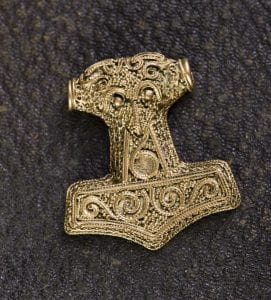Ásatrú Funeral Service Rituals
 Because Ásatrú (meaning “belief in the Gods”) is an ancestral polytheistic religion focused on deeds, the religion’s funeral customs involve remembering the deeds of the deceased and retelling fond memories. Followers do not fear death because they do not believe in a painful or torturous afterlife. When loved ones pass, they are believed to enter a place of joy, rest, and healing.
Because Ásatrú (meaning “belief in the Gods”) is an ancestral polytheistic religion focused on deeds, the religion’s funeral customs involve remembering the deeds of the deceased and retelling fond memories. Followers do not fear death because they do not believe in a painful or torturous afterlife. When loved ones pass, they are believed to enter a place of joy, rest, and healing.
The deceased are often buried with grave goods such as weapons, swords, tools, food, and jewelry. Funeral flowers may also be arranged on top of the casket. For Ásatrú, both interment and cremation are viable options, and family members and loved ones carry out the deceased’s wishes. In the case of cremation, the grave goods are burned with the body.
The thors hammer symbolizes Ásatrú faith, and one must be burned or buried at every funeral. Music is also a prominent feature of services, and modern Scandinavian songs are chosen to convey feelings of sadness and loss. The deceased’s favorite musical pieces are often included in the service, which lasts anywhere from 30 to 90 minutes.
The basic elements of an Ásatrú funeral service include the hallowing, an introduction, a reading, a time of memorial, the final prayer, and the closing. The space where the funeral is being held is hallowed with a hammer before the service can occur. A short introduction follows. Intended for people outside the Ásatrú faith, the introduction helps develop a context for the rest of the funeral services.
Readings at Ásatrú funerals generally come from the Poetic Edda. In most cases, Hávamál 76 is read:
Cattle die, kinsmen die
the self must also die;
I know one thing which never dies:
the reputation of each dead man.
The memorial follows the reading, where people who knew the deceased speak about the individual’s deeds and life. During this time, a farvel cup (memory cup) will be raised to toast the deceased’s memory. The cup may be passed around and shared in very intimate funeral settings. During this time, any deeds that remain unfinished are taken up by those who are still living. This could include things like caring for the family left behind. In addition, the memorial part of the funeral service may include sharing and laughing at fond memories, crying over shared grief, and reciting favorite poems. All of these things serve to preserve the memory of the deceased.
The final prayer follows the time of the memorial. The Norse prayer recorded in Ibn Fadhlan’s memoirs is most often recited, but any prayer may be used. While specific practices may vary, it is not uncommon for a copy of the closing prayer to be distributed and recited by everyone in attendance. This is to symbolize the joining together of those at the service. Following the prayer, a few words will be said to close the ceremony.
